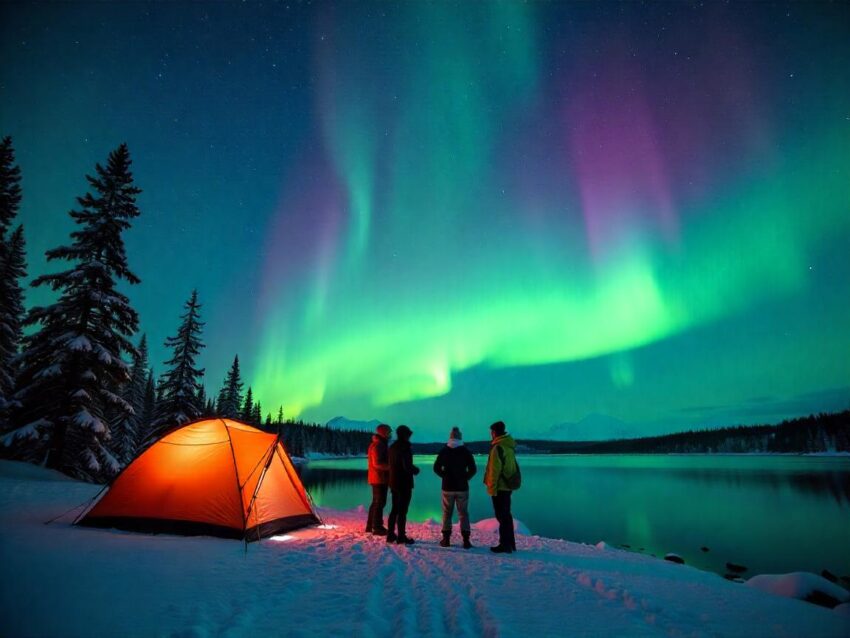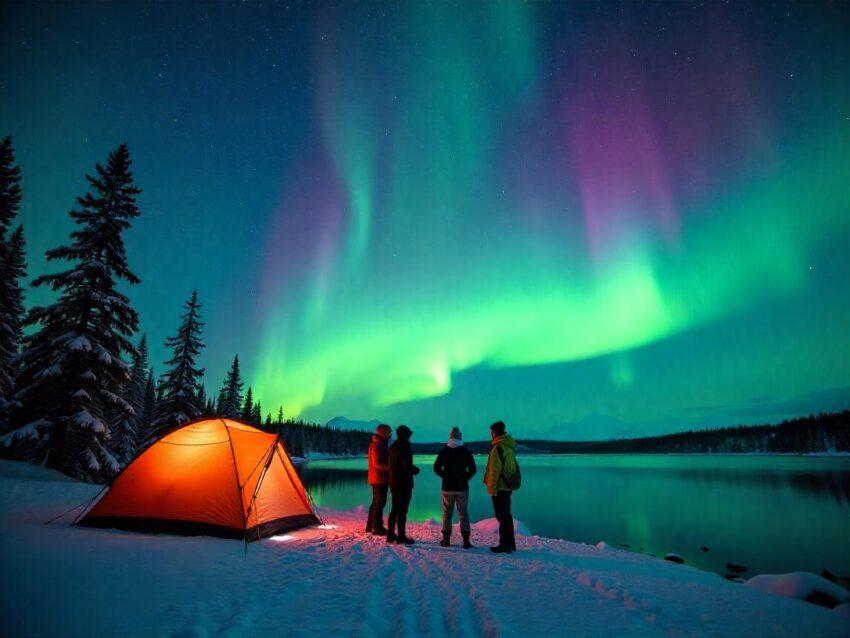[[{“value”:”

In a dazzling twist of nature, the US joins Canada, Ireland, Norway, Sweden, Germany, Poland, and Finland under skies lit by the rare glow of the Northern Lights. But this time, the wonder isn’t just dancing over the Arctic Circle—it’s dropping down low, far lower than usual. And now, thanks to a severe geomagnetic storm, travelers are racing to Washington, Oregon, Idaho, Montana, North Dakota, Minnesota, Wisconsin, and Michigan for a once-in-a-generation chance to witness this cosmic spectacle.
This severe geomagnetic storm is no ordinary solar event. It has pushed the Northern Lights into territories where they rarely appear, casting eerie greens and vibrant purples across skies from Europe to North America. And as the storm strengthens, curiosity rises. What does it mean? Why now? And why these countries?
And now is the time to travel. Clear skies are forecasted across the Midwest and Pacific Northwest. The viewing window is tight, the intensity is high, and the experience promises unforgettable visual drama. But not every city will have the same view. You need to escape the urban glare, face north, and let your eyes adjust to a natural wonder that’s defying borders.
Aurora Over America: Northern Lights to Grace Skies Across U.S. as Severe Solar Storm Unleashes Rare Travel Opportunity
The sky is preparing for an unforgettable performance. For one night only, Americans from the Pacific Northwest to the Deep South may witness a celestial spectacle typically reserved for Arctic explorers. Thanks to a severe geomagnetic storm, the Northern Lights—one of the world’s most elusive natural wonders—are expected to dance across the skies of the continental US
From Michigan to Northern California, and as far south as Alabama, the aurora borealis may paint the night with glowing ribbons of green, purple, and red light. What makes this moment even more magical is its rarity—and the sheer scale of its reach.
A Cosmic Event That’s Rewriting the Rules of Travel
The Northern Lights are typically visible only in high-latitude locations like Iceland, Greenland, or northern Canada. But tonight, nature is offering a front-row seat to millions more, right across the American heartland.
Driven by a powerful coronal mass ejection—a massive burst of solar plasma colliding with Earth’s magnetic field—this particular geomagnetic storm has reached a G4 intensity, one step below the most extreme level measured by space weather experts. That level of force is enough to shove the lights far beyond their usual zone.
This sudden shift has triggered a surge of excitement among travelers, sky-watchers, photographers, and tourism boards alike.
Best Viewing Zones and Timing
The clearest views are expected in states like Washington, Oregon, Idaho, Montana, North Dakota, Minnesota, Wisconsin, and Michigan. However, skies are also predicted to be mostly clear in Northern California, parts of the Midwest, the Ohio Valley, and Mid-Atlantic states—offering wider-than-usual visibility.
Timing is critical. The best window is between 10 p.m. and 2 a.m. local time, when the skies are darkest and the Earth’s magnetic field is most energized.
City dwellers are advised to escape urban light pollution. Traveling just 30 to 60 minutes outside city limits into darker rural areas could make all the difference. And for those in overcast regions—like New York City, where cloud cover is expected—hope lies in smartphone cameras, which can sometimes capture auroras even when eyes cannot.
A Sudden Boost for Local Tourism
As news of the aurora’s reach spreads, regional tourism centers are seeing a spike in last-minute travel interest. Lodges in the Pacific Northwest, rural campgrounds in Michigan’s Upper Peninsula, and parks in Montana and Idaho are all preparing for a rush of visitors.
State parks and dark sky reserves are capitalizing on the moment with extended hours and special programming. Local businesses—from hotels to gas stations—are experiencing a short-term tourism boost, similar to what happens during meteor showers or solar eclipses.
Social Media Sparks a Digital Travel Frenzy
Social media is fueling a wildfire of real-time sharing. Hashtags like #NorthernLightsUSA, #AuroraWatch, and #SkyShow2025 are trending nationally. Travelers are posting maps, updates, and photos as the event unfolds, encouraging others to hit the road.
This burst of online engagement not only amplifies interest but also turns a natural event into a tourism phenomenon. Travel influencers and nature content creators are using the moment to highlight rural destinations, night-sky photography, and lesser-known scenic routes.
The Science Behind the Magic
At the heart of this event is the Sun itself. A solar storm occurs when the Sun ejects high-energy particles toward Earth, disturbing the magnetic field that surrounds our planet. When those charged particles interact with the Earth’s atmosphere, they excite oxygen and nitrogen atoms—producing light that dances across the sky.
What makes tonight different is the intensity of the solar storm. The G4 classification means this is among the most powerful in recent years, capable of producing visible auroras much farther south than usual.
While beautiful, these events can also interfere with power grids, satellite communication, and even airline navigation. However, space weather agencies assure that current impacts will remain limited and manageable.
A Reminder of Nature’s Surprises
Moments like these capture something deeper: the wonder of nature’s unpredictability. For travelers who chase rare events, this one is a gem. No flights to Alaska or Iceland needed—just a warm coat, a dark spot, and eyes to the northern sky.
It’s also a moment of connection. Across time zones, strangers are sharing a unified experience, marveling at the same swirling colors, awed by a force that comes from 93 million miles away.
In a world shaped by routine, the Northern Lights serve as a reminder that even in the ordinary, the extraordinary can arrive without notice.
How to Make the Most of It Tonight
- Check real-time aurora forecasts via NOAA’s Space Weather Prediction Center.
- Get outside major cities. The darker the skies, the better the view.
- Face north and give your eyes 20 minutes to adjust to the dark.
- Use a smartphone camera on night mode or long exposure to help catch faint lights.
- Stay warm and bring hot drinks—you may be out there a while!
Final Thought: A Night to Remember
Whether you catch the lights shimmering over a snowy field or only glimpse them through a smartphone screen, tonight is a chance to witness a phenomenon that unites science, travel, and emotion.
The skies are open. The storm is here. And the Northern Lights are calling—maybe right outside your door.
The post US Joins with Canada, Ireland, Norway, Sweden, Germany, Poland, Finland as Northern Lights to Be Seen Due to Severe Geomagnetic Storm, Now Travel to Washington, Oregon, Idaho, Montana, North Dakota to See This appeared first on Travel And Tour World.”}]] [[{“value”:”US joins Canada, Ireland, Norway, Sweden, Germany, Poland, and Finland under skies lit by the rare glow of the Northern Lights. But this time, the wonder isn’t just dancing over the Arctic Circle
The post US Joins with Canada, Ireland, Norway, Sweden, Germany, Poland, Finland as Northern Lights to Be Seen Due to Severe Geomagnetic Storm, Now Travel to Washington, Oregon, Idaho, Montana, North Dakota to See This appeared first on Travel And Tour World.”}]]  Read More America Travel News, Travel News Pick, TRAVEL TRENDS AND FOCUS, Alabama aurora visibility, Aurora tourism, California sky show, dark sky parks USA, G4 solar storm, geomagnetic storm aurora, Michigan aurora forecast, Midwest skywatching, national parks night events, Northern Lights USA 2025, Pacific Northwest Northern Lights, Space Weather Prediction Center, stargazing destinations 2025, travel to see aurora borealis, US space weather TRAVEL TRENDS AND FOCUS – Travel And Tour World
Read More America Travel News, Travel News Pick, TRAVEL TRENDS AND FOCUS, Alabama aurora visibility, Aurora tourism, California sky show, dark sky parks USA, G4 solar storm, geomagnetic storm aurora, Michigan aurora forecast, Midwest skywatching, national parks night events, Northern Lights USA 2025, Pacific Northwest Northern Lights, Space Weather Prediction Center, stargazing destinations 2025, travel to see aurora borealis, US space weather TRAVEL TRENDS AND FOCUS – Travel And Tour World



